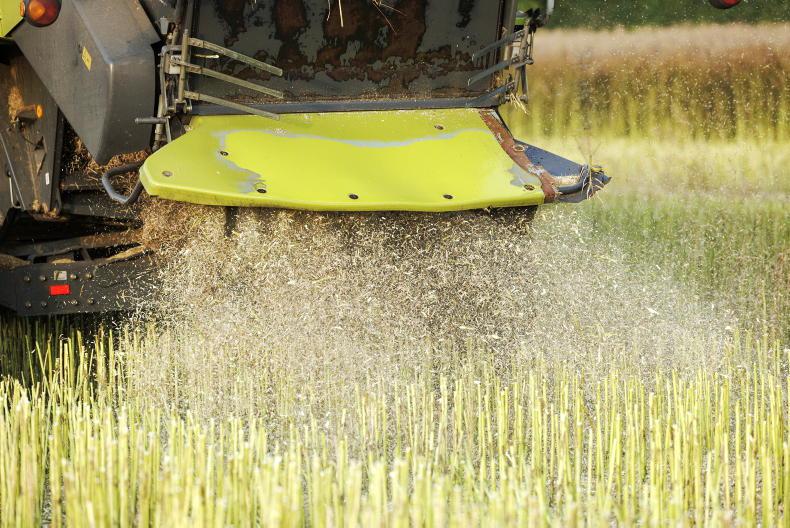There’s a lot of talk about straw at present, as farmers have struggled to bale much of their crops across the harvest due to weather.
However, progress has been made in the last few weeks.
Straw is an extremely valuable commodity. It is needed for animal feed and bedding and contains phosphorus (P) and potassium (K) as well as carbon (C), which, when added to the soil, can help to reduce fertiliser bills and improve soil structure.
Straw production
Straw production is back this year due to a number of factors – the first being the lower area of winter crops planted.
Approximately 20,000ha less winter barley was planted this season, as poor weather had impacted the area sown. Winter barley is, of course, a major contributor to the straw market. Total cereal area is back by approximately 17,500ha.
Spring barley straw yields are reported to be back as well, with current ranges from 4 to 7 round 4X4 bales/ac being reported across the country.
There has also been a significant increase in the area of straw entered into the Straw Incorporation Measure this season. Approximately 56,500ha of cereals were entered into the scheme, although some of this area is expected to have been withdrawn.
Meanwhile, 13,900ha of oilseed rape straw are estimated to be entered for chopping in the scheme.
Values of P and K
Teagasc has released 2023 values for P and K in straw. It should be noted that the values are probably lower for some crops across the country, as crops are generally yielding lower than the reference yields Teagasc has outlined.
Taking an early-sown crop of spring barley, most of those crops yielded over 7.5t/ha (3t/ac) and hit up to 9t/ha (3.75t/ac).
So, these straw crops most likely have a P and K value of €66/ha. This figure places P at a cost of €3.28/kg and K at a cost of €1.11/kg. See Table 1 for the breakdown of P and K values for the straw in a number of different crops.
At seven bales/ac or 17 bales/ha, that’s a value of €3.88 for P and K per bale. The value of that straw to the soil, aside from P and K, is then impossible to place a monetary value on. It will impact on the soil and crops for years to come.
Farmers who incorporate straw back into their soil often comment that aside from an improvement in crops, they burn less diesel, as their soil structure improves.
Costs of producing straw
Machinery costs are not going down either. The FCI places the cost of baling 4X4 round bales at €6-€7/bale. Add €10-€12/ac to turn the straw, and remember some crops were turned more than once this year, and you’re at €8-€9/bale.
So, with one turn, baling and P and K values the cost of straw is at approximately €12.50/bale before you add any cost for losing the carbon or value to the soil.
Loading in the field is another cost to add on at about €60/hour or €1.50/bale. That places costs at €14.08/bale before accounting for selling the carbon and the benefit of the straw to the soil. At these costs, chopping and receiving a payment of €250/ha or €100/ac can make sense.
Straw incorporation
The Straw Incorporation Measure was introduced to encourage farmers to return straw, which is high in carbon, back to the soil. Straw incorporation is outlined as one of the methods in the Government’s Climate Action Plan to help offset agricultural emissions.
Cereal and oilseed rape straw can be chopped under the scheme. Many livestock farmers can be frustrated by the scheme in years where straw is scarce compared to other years, and they make the argument that it is better for animals to use the straw for bedding and to apply it to soil then. However, the farmyard manure is usually not transferred back to the tillage farm and so nutrients being taken away are not being replaced.
Farmyard manure is a great addition to soils and can really help to improve soil health and structure. It also adds carbon to the soil from the straw and the manure.
However, figures from Teagasc show that the carbon levels returned to the soil from chopped straw are higher than those from farmyard manure (see Table 3).
Looking at Table 3, it is clear that straw incorporation is by far the most efficient way to put carbon into the soil.
Farmyard manure is the second most efficient, followed by a cover crop and then slurry.
Chopping also takes a number of risks out for the tillage farmer. First of all, they return the P, K and carbon back to the soil and do not lose out on the value of that fertiliser, which they do if they sell the straw.
Secondly, if farmyard manure is to be shared between tillage and livestock farms, tillage farmers need to be sure that all straw on the livestock farm is from their own farm.
Otherwise, there is a risk of grass weeds from one farm being transferred to another, which could bring serious issues for the tillage farmer and add huge costs for grass weed control in the future.
It’s a difficult year for all farmers. Weather has made many jobs challenging and straw yields and baling have been hit badly.
Hopefully, everyone comes to fair payment rates for straw and all sectors work together.
The straw scheme has been a positive for the tillage sector, and this season, it has helped farmers in bad weather conditions.






 This is a subscriber-only article
This is a subscriber-only article











SHARING OPTIONS: